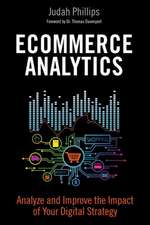The Economic Value of Information
Autor David B. Lawrenceen Limba Engleză Hardback – 22 apr 1999
| Toate formatele și edițiile | Preț | Express |
|---|---|---|
| Paperback (1) | 895.58 lei 43-57 zile | |
| Springer – 26 sep 2012 | 895.58 lei 43-57 zile | |
| Hardback (1) | 1005.09 lei 43-57 zile | |
| Springer – 22 apr 1999 | 1005.09 lei 43-57 zile |
Preț: 1005.09 lei
Preț vechi: 1225.72 lei
-18% Nou
Puncte Express: 1508
Preț estimativ în valută:
192.33€ • 201.31$ • 160.07£
192.33€ • 201.31$ • 160.07£
Carte tipărită la comandă
Livrare economică 31 martie-14 aprilie
Preluare comenzi: 021 569.72.76
Specificații
ISBN-13: 9780387987064
ISBN-10: 0387987061
Pagini: 416
Ilustrații: XV, 393 p.
Dimensiuni: 155 x 235 x 28 mm
Greutate: 0.75 kg
Ediția:1999
Editura: Springer
Colecția Springer
Locul publicării:New York, NY, United States
ISBN-10: 0387987061
Pagini: 416
Ilustrații: XV, 393 p.
Dimensiuni: 155 x 235 x 28 mm
Greutate: 0.75 kg
Ediția:1999
Editura: Springer
Colecția Springer
Locul publicării:New York, NY, United States
Public țintă
ResearchDescriere
The Scope of This Book Popular culture often refers to current times as the Information Age, classifying many of the technological, economic, and social changes of the past four deca:les under the rubric of the Information Revolution. But similar to the Iron Age be fore it, the description "Information Age" suggests the idea that information is a commodity in the marketplace, one that can be bought and sold as an item of value. When people seek to acquire information yet complain about information overload, and when organizations invest millions in information systems yet are unable to pinpoint the benefits, perhaps this reflects a difficulty with the as sessment of the value of this commodity relative to its cost, an inability to dis cern the useless from the useful from the wasteful. The Information Age requires us to assess the value, cost, and gain from information, and to do it from several different viewpoints. At the most elementary level is the individual who perceives a need for in formation-her current state of knowledge is insufficient and something needs to be understood, or clarified, or updated, or forecast. There is a universe of al ternative information sources from which to choose, some more informative than others, some more costly than others. The individual's problem is to evalu ate the alternatives and choose which sources to access. An organization comprising many information-seeking employees and agents must take a somewhat broader viewpoint.
Cuprins
1. Introduction and Overview.- 1.1 Information in Decision Making.- 1.1.1 The Basic Framework for Decision.- 1.1.2 Information and Information Sources.- 1.1.3 Statistical and Pragmatic Information.- 1.1.4 Ex-Post Value and Gain.- 1.2 Information in the Organization.- 1.2.1 Information Systems.- 1.2.2 User Information Processing.- 1.2.3 Information System Accounting.- 1.3 Economics of the Incorporation of Information.- 1.3.1 The Criterion.- 1.3.2 Ex-Ante Components of Decision Making.- 1.4 The Expected Value of an Information Source.- 1.4.1 Information Structure and Informativeness.- 1.4.2 The Measurement of Information Value: Chapters 2 and 3.- 1.4.3 The Assessment of Information Value: Chapters 4 and 5.- 1.4.4 Case Studies of Information Value.- 1.4.5 The Theory of Information Value: Chapters 6 and 7.- 1.5 Information Value, Cost, and Procurement.- 1.5.1 The Optimal Information Structure.- 1.5.2 Procuring Direct Information.- 1.5.3 Case Studies of Information Cost, Value, and Choice.- 1.6 System Design for Information Gain.- 1.6.1 Decision Theory, Information Science,and System Design.- 1.6.2 Information Use Environments.- 1.6.3 A Model of System Design and User Behavior.- 1.7 Information Social Science.- 1.7.1 The Information Society.- 1.7.2 How Monumental Are Recent Events?.- 2. The Value of the Informed Decision.- 2.1 Elements of a Decision Problem Under Uncertainty.- 2.1.1 Utility of Outcome.- 2.1.2 Decision Problems.- 2.1.3 Decision Making.- 2.2 The Framing of the Decision Problem.- 2.2.1 Practical Issues in Framing.- 2.2.2 Framing the State Space and Initial Knowledge.- 2.2.3 The Incorporation of Information.- 2.3 Useful Facts About Statistical Information.- 2.3.1 Statistical Properties of the Information Structure.- 2.3.2 The Finite Model.- 2.3.3 Some Specific Expectations.- 2.4 Value of the Informed Decision.- 2.4.1 Extensive Form Analysis.- 2.4.2 Perfect Information.- 2.4.3 Worthless Information.- 3. Measures of the Value of Information.- 3.1 Measures of the Value of a Message.- 3.1.1 Cash-Equivalent Values of a Decision.- 3.1.2 Value of Decisions Posterior to the Message.- 3.1.3 The Simplest Special Case.- 3.1.4 Two Examples.- 3.1.5 The Need for Preposterior Evaluation.- 3.2 Measures of the Value of a Source.- 3.2.1 Incremental Value from Incorporating Information.- 3.2.2 The Range of the Expected Value of Information.- 4. The Assessment of Statistical Information.- 4.1 Coherent Assessment of Probability Distributions.- 4.1.1 Coherence and Consistency.- 4.1.2 Families of Probability Densities.- 4.2 Assessment of Beliefs and Foreknowledge.- 4.2.1 Assessing a Univariate Distribution.- 4.2.2 Obtaining Qualitative Foreknowledge of Information.- 4.2.3 Expert Resolution.- 4.2.4 Analysis of a Track Record.- 4.3 Simplifying the Assessment.- 4.3.1 The Preposterior Mean.- 4.3.2 The Calibrated Noiseless Model.- 5. Models with Convenient Assessment and Interpretation.- 5.1 Models with Payoff Quadratic in the Action.- 5.1.1 The General Case.- 5.1.2 The Bivariate Normal Case.- 5.1.3 The Quadratic Team.- 5.2 Models with Payoff Linear in the State.- 5.2.1 Raiffa and Schlaifer’s Approach.- 5.2.2 Application to Statistical Decision Problems.- 5.2.3 Application in a Dichotomy.- 5.2.4 The Inventory Problem.- 5.3 Models with Concave-Exponential Utility.- 5.3.1 Information Value with Separable Outcome.- 5.3.2 Applications with the Bivariate Normal Information Structure.- 5.4 Models with Nonseparable Outcome; Betting and Investing Models.- 5.4.1 Nonseparability and Information Value:Two Examples.- 5.4.2 Arrow’s Contingent Securities Model.- 5.5 Models with Multicategorical State Description.- 5.5.1 Multicategorical Information Structures.- 5.5.2 Bidding Models.- 5.6 Dynamic Models and the Role of Timeliness.- 5.6.1 Dynamic Decision Problems.- 5.6.2 Delay.- 5.6.3 The Value of Timeliness and Accuracy.- 5.6.4 Assessing the Joint Distribution of Messages and States Via the Kalman Filter.- 5.6.5 Stochastic Control Theory.- 5.7 Approximations and Bounds for the Value of Information.- 5.7.1 Use of the Taylor Series Expansion.- 5.7.2 Bounds for Stochastic Programming Problems.- 5.7.3 Approximating Information Value by Sampling.- 6. Statistical Determinants of Information Value.- 6.1 The Normal Form of Decision Analysis.- 6.1.1 Randomized Courses of Action.- 6.1.2 Decision Rules.- 6.1.3 Utility Possibilities and Admissibility.- 6.1.4 The Finite Model in Normal Form.- 6.1.5 Convexity in the Probabilities.- 6.2 Comparative Informativeness.- 6.2.1 The Relation “More Informative Than”.- 6.2.2 Blackwell’s Theorem.- 6.2.3 Special Cases.- 6.2.4 Constructing a Sequence of Structures Ranked by Informativeness.- 6.3 Informativeness, Prior Knowledge, and Value.- 6.3.1 The Value of Statistical Informativeness: The Binary Case.- 6.3.2 The Value of Systematic Redistribution of the Probability: Stochastic Dominance.- 6.3.3 The Differential Approach to the Value of Statistical Informativeness.- 6.3.4 Environmental Uncertainty.- 7. Stochastic Preference and Information Value.- 7.1 Prospects and Attitude Towards Risk.- 7.1.1 Prospects Induced by Actions.- 7.1.2 Cash Summarizations for Optimal Prospects.- 7.1.3 Attitude Towards Risk.- 7.2 Risk Preference and Information Value.- 7.2.1 Comparison of the Risk Averter’s Optimal Prospects with the Risk Neutral Benchmark.- 7.2.2 Bounds on the Comparative Demand Value of Information.- 7.3 Nonlinear Models and Information Aversion.- 7.3.1 The Expected Utility Criterion.- 7.3.2 Troubles with the Expected Utility Model.- 7.3.3 Aversion to Information.- 8. Information Demand and Procurement.- 8.1 The Demand for Information.- 8.1.1 The Value of the Costly Informed Decision.- 8.1.2 Economic Consequences of Differential Information.- 8.1.3 Optimal and Suboptimal Information Possession.- 8.2 Information Procurement.- 8.2.1 The Informant as Agent of the DM.- 8.2.2 The Framework and Primary Assumptions.- 8.2.3 The Contract Design Problem.- 8.3 Optimal Incentive Contracts to Procure Information.- 8.3.1 The Expected Value of Information.- 8.3.2 The Optimal Contract Design.- 8.3.3 Implementation.- 8.3.4 Examples.- 8.3.5 Proofs of Lemmas 2, 3, and 4.- 9. Economics of Valuable Information Systems.- 9.1 Information Use Environments.- 9.1.1 Business Environments.- 9.1.2 Scientific and Technical Environments.- 9.1.3 User Assessment of Information Value.- 9.2 System Design and Information Gain.- 9.2.1 The Gain-Producing Activities of an Information System.- 9.2.2 System Data Processing.- 9.2.3 Design and Performance.- 9.3 Experiments in Ex-Ante Information Behavior.- 9.3.1 Normative and Descriptive Economics.- 9.3.2 Experiments in Information Acquisition.- 9.3.3 Experiments in Value Assessment.- 9.4 A Decision-Theoretic Model for System Design.- 9.4.1 The Framework.- 9.4.2 A Theory of Information Production and Cost.- 9.4.3 Information Gain in a Canonical Decision Problem.- 9.4.4 Reported Results from a Survey.- 9.4.5 Characterization of the Organization’s Optimal System.- 9.5 Postlude.- References.- Acknowledgments.- Symbol Glossary.- Author Index.












